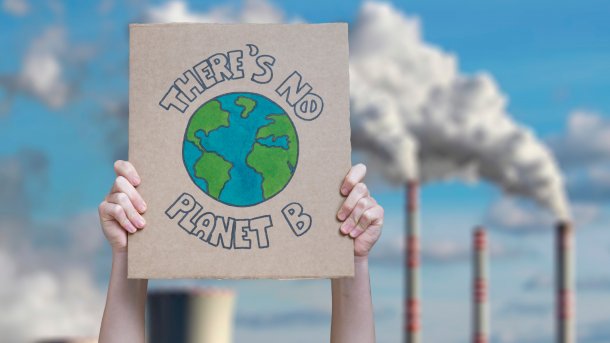"Cleaning up the atmosphere": It won't work without CO2 removal - study says
Without actively removing CO2 from the atmosphere, it is unlikely to work. Researchers are calling for incentives and a legal framework for the methods.

(Bild: nicostock/Shutterstock.com)
(Hier finden Sie die deutsche Version des Beitrags)
Not surprisingly, current efforts to reduce CO₂ emissions are far from sufficient to meet the Paris climate target of global warming below 1.5 degrees Celsius. This is also shown by the Climate Action Tracker in its assessment for 2022, although even reaching the 1.5-degree limit is dangerous because it would trigger several climate tipping points, as the Potsdam Institute for Climate Impact Research warned in September 2022. With around 40 billion metric tons of CO₂ emitted by humankind in 2022, it will only take eight years until the 1.5 degrees could be reached, calculated the Global Carbon Project.
If even the unlikely happens that the limit is not exceeded through massive emission reductions, there will still be the releases from agriculture, heavy industry and shipping, which are difficult to avoid, and which will continue to have to be recovered from the air over decades.
The recently published report entitled "The State of Carbon Dioxide Removal (CDR)" now provides a precise insight into the potential of approaches to remove quantities of CO₂ from the atmosphere and store them permanently. Methods for capturing and storing carbon from the combustion of coal, oil and gas (CCS) are not considered in it because they do not contribute to a decrease, but only prevent the CO₂ increase.
Cleaning up the atmosphere
The extensive analysis shows a large gap between what states plan to do to get CO₂ out of the atmosphere and what is needed to meet the Paris Climate Agreement goal.
The countries' plans do not go beyond 2050 anyway. One of the authors, Jan Christoph Minks of the Mercator Research Institute on Global Commons and Climate Change (MCC), points out: "In the longer term, we may have to start thinking about cleaning up the atmosphere today, because the climate damage is already really considerable. But to do that, we actually then have to remove CO₂ from the atmosphere on a net basis."
Now, of course, in the first half of the 21st century, the focus is still on avoiding and reducing greenhouse gases. In the second half of the 21st century, active CO₂ removal should then dominate climate protection. "Of course, we have to think about that today: what do we have to do to make that really happen then," Minks said.
Currently, around two gigatons of CO₂ of the 40 man-made gigatons per year are removed from the atmosphere again, primarily through reforestation and the management of existing forests. The newer methods contribute just two million tons, 0.1 percent, to this effort. Among these newer methods, scientists include, for example, bioenergy with CO₂ capture (BECCS), plant carbon, or direct capture of CO₂ from the air (DAC) with chemical air filters.
Three scenarios: How much CO₂ actually has to be removed
The report uses three scenarios to show how large the gap is between current efforts and the necessary reductions.
If the focus of climate policy is on energy generation through renewables, an additional 5.4 gigatons of CO₂ will nevertheless have to be removed in 2030, and as much as 7.6 gigatons in 2050. If we rely on the natural removal methods currently in use (such as forests and peatlands), this still leaves 3.9 gigatons in 2030 that will have to be eliminated by other means. Because forests, for example, cannot be expanded at will, the gap would be 9.8 gigatons in 2050. However, if the world were to focus on reducing its consumption and demand for goods, there would only be 3.5 gigatons to eliminate in 2030, but still 4.7 gigatons of CO₂ in 2050.
As yet, novel CDR processes, such as direct air capture, enhanced weathering and new carbon-rich materials, are still at an early stage of development. They therefore need a significant push, the report says. A CO₂ price incentive and an appropriate regulatory framework are needed to scale up known conventional onshore CDR methods and introduce new techniques on a large scale, it says. This is also important so that companies and society do not put off efforts to further reduce and avoid greenhouse gases.
But there is also hope. "Innovation in CDR has increased significantly in recent years," the authors note. Evidence of this, they say, is the more than $4 billion in publicly funded research, plus an increase in patents, but also more investment in new CDR capacity of around $200 million between 2020 and 2022.
China's progress in CO₂ removal
China leads the world in this respect, registering 36 percent of all patents for these new methods, especially in the direct separation of climate gas from the air. The country also leads in research, as the authors of the report can show from the number of scientific and peer-reviewed publications.
China is also far advanced in practice and is using plant charcoal for CO₂ removal throughout the country, as co-author Oliver Geden from the German Institute for International and Security Affairs at the Stiftung Wissenschaft und Politik reports: "In Nanjing province, it is no longer permitted to burn rice straw. That's why they make charcoal out of it, which they either use in building materials or simply fertilize with it."
The status report on carbon dioxide removal from the atmosphere is to be published annually from now on. This is because CO₂ concentrations are changing, the level of knowledge about CO₂ removal methods is increasing, and access to data sources is also improving.
(jle)